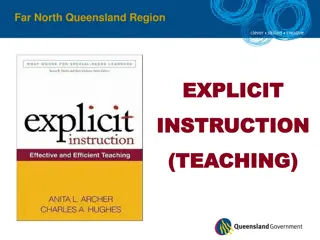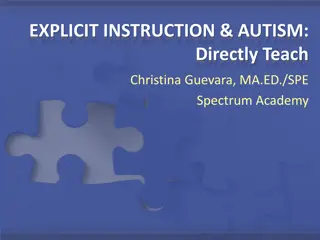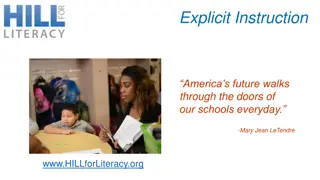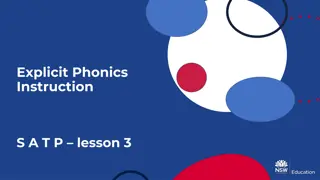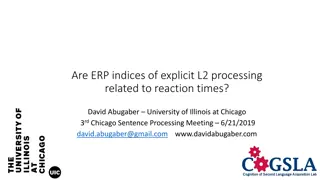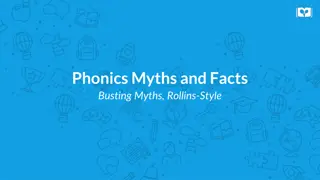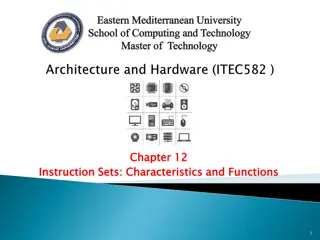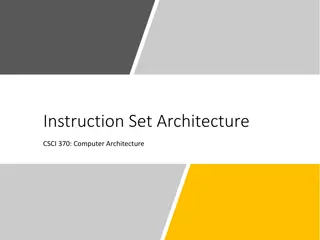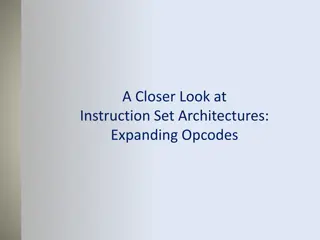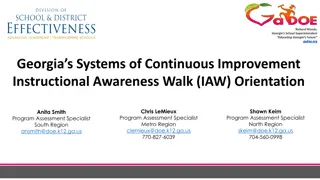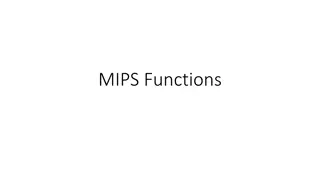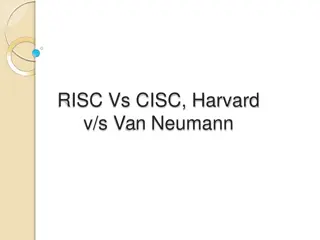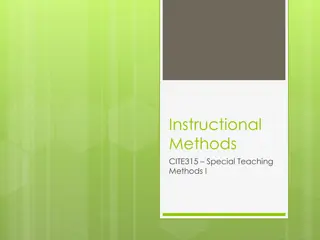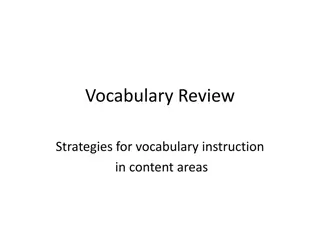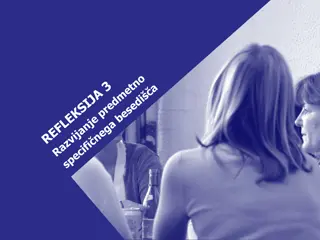Understanding the Importance of Clarity in Explicit Instruction
Explicit instruction is closely tied to teacher clarity, which involves behaviors that help students comprehend and retain information. Achieving clarity in communication is vital for effective teaching, as it ensures understanding and engagement between teachers and students.
Download Presentation

Please find below an Image/Link to download the presentation.
The content on the website is provided AS IS for your information and personal use only. It may not be sold, licensed, or shared on other websites without obtaining consent from the author. Download presentation by click this link. If you encounter any issues during the download, it is possible that the publisher has removed the file from their server.
E N D
Presentation Transcript
Clarity Clarity Clarity Clarity March 5, 2021 Explicit Instruction Academy Webinar Anita L. Archer, PhD 1
Hattie,2019 Variables Related to Explicit Instruction d Variables Related to Explicit Instruction d Explicit Teaching Procedures .57 Scaffolding .58 Direct Instruction .59 Response to Intervention 1.09 Mastery Learning .61 Collective Teacher Efficacy 1.57 Goals .51 Teacher-Student Relationships .52 Clarity 1.09 Teacher Credibility 1.09 Questioning .48 Comparisons Classroom Discussions .82 Whole Language .06 Feedback .66 Discovery-Based Teaching .21 Deliberate Practice .79 Problem-based Learning .35 Rehearsal and Memorization .65 Student Control over Learning .02 Spaced Practice .65 Retrieval Practice .46 2
What is the relationship of Explicit What is the relationship of Explicit Instruction to Instruction to CLARITY? CLARITY? 3
Explicit Instruction is Explicit Instruction is Clarity Clarity!! !! Teacher clarity are behaviors enacted by a teacher that assists students in selecting, understanding, and remembering the structure and details of information. 4
Clarity Clarity Clarity Clarity A measure of the clarity of communication between teachers and students in both directions. Fendick, 1990 Clarity of Speech - All can hear, few vague terms, good English Clarity of Organization - Objective, content coverage, review Clarity of Explanation - Explanations, demonstrations, directions, small steps Clarity of Examples and Guided Practice - Examples, questions, practice activities, feedback Clarity of Assessment of Student Learning - Formative assessment, checks of learning Fendick & Titsworth 5
Clarity Clarity Clarity Clarity A measure of the clarity of communication between teachers and students in both directions. Fendick, 1990 Student surveys (Bush et al., 1977; Kennedy, Cruickshank, Bush, and Myers, 1978) Behaviors of Clearest Teachers Understandable manner and appropriate pace Gives explanations that students understand. Use examples and illustrations when presenting information Gives students an example and lets them try to do it. Assesses student learning Tries to find out if we understand and then repeats things. Provides time to think Gives us a chance to think about what s being taught. 6
Clarity Clarity Clarity Clarity A measure of the clarity of communication clarity of communication between teachers and students in both directions. Elements of Explicit Instruction Content 1. Focus instruction on critical content. 2. Sequence skills logically. 3. Break down complex skills and strategies into instructional units. 7
3. Break down complex skills and strategies into instructional units. I can write a summary of a section of informative text. 8
3. Break down complex skills and strategies into instructional units. Writing Process Plan and outline Create a draft Revise the draft Edit the draft The Writing Revolution by Judith C. Hochman and Natalie Wexler 9
3. Break down complex skills and strategies into instructional units. Topic _______________ Topic Sentence ____________________________________ _________________________________________________ Details - Notes 1. _______________________________________________ ________________________________________________ 2. _______________________________________________ _________________________________________________ 3. _______________________________________________ _________________________________________________ 10
3. Break down complex skills and strategies into instructional units. 1. Plan: Can determine and record the topic and three critical details of a section of informative text. Plan: Can determine and record the topic, three important details, and a topic sentence for a section of informative text. a. The topic sentence communicates the main idea of the summary. b. The details support the main idea. Draft: Using a plan, can write a draft summary containing a topic sentence and related detail sentences. Revise: Can revise by expanding sentences and adding transitions. Edit: Can check for errors in spelling, punctuation, and capitalization. 2. 3. 4. 5. 11
Clarity Clarity Clarity Clarity A measure of the clarity of communication clarity of communication between teachers and students in both directions. Elements of Explicit Instruction Design of Instruction 4. Design organized and focused lessons. 5. Begin lessons with a clear statement of the lesson goals and your expectations. 6. Review prior skills and knowledge before beginning instruction. 7. Provide step-by-step demonstrations. 8. Provide guided and supported practice. 9. Use clear and concise language. 10. Provide an adequate range of examples and non-examples. 12
Lesson goals Learning Intentions (a sequence) I can plan a paragraph summary including the topic and three important details. I can plan a paragraph summary including a topic sentence and three important details. I can plan and draft a summary paragraph that includes a topic sentence and three detail sentences. I can revise the summary paragraph by expanding sentences and adding transitions. I can edit the summary paragraph for spelling, punctuation, and capitalization. 13
Lesson Goals Moss, Brookhart, & Long 1968 Guiding Question What will I be able to do when I ve finished this lesson? I can plan a paragraph summary including the topic and three important details. What idea, topic, or subject is important for me to learn and understand so that I can do this? To be able to do this, I must learn: What a topic is How to determine the topic of text How to determine important details about a topic How to add notes to my plan What will I do to show that I can do this, and how well will I have to do it? I will show that I can do this by adding the topic and notes about the three important details to my plan. 14
Topic _______________ Topic Sentence ____________________________________________ ____________________________________________ Details - Notes 1.____________________________________________ _____________________________________________ 2.____________________________________________ _____________________________________________ 3.____________________________________________ _____________________________________________ 15
Lesson Goals Moss, Brookhart, & Long 1968 I can plan a paragraph summary including the topic and three important details. To be able to do this, I must learn: What a topic is How to determine the topic of text How to determine important details about a topic How to add notes to my plan I will show that I can do this by completing a plan. My plan will include the topic and three important details. 16
Clarity Clarity Clarity Clarity A measure of the clarity of communication clarity of communication between teachers and students in both directions. Elements of Explicit Instruction Delivery of Instruction 11. Require frequent responses. 12. Monitor student performance closely. 13. Provide immediate affirmative, informative, and corrective feedback. 14. Deliver the lesson at a brisk pace. 15. Help students organize knowledge. 17
Topic plants that eat animals______________ Topic Sentence ____________________________________________ ____________________________________________ Details - Notes 1. Venus Fly Trap______________________________ _____________________________________________ 2.Sundew_____________________________________ _____________________________________________ 3.Pitcher Plant _______________________________ _____________________________________________ 18
Clarity Clarity Clarity Clarity A measure of the clarity of communication clarity of communication between teachers and students in both directions. Elements of Explicit Instruction Judicious Practice 16. Provide distributed and cumulative practice. Deliberate Practice (Goal-oriented) Clarify and Verify Retrieval Practice (From memory) Spaced Practice (Distributed) 19
Topic _____________________ What the section was about Topic Sentence _____________ The main idea of the summary ____________________________________________ Details Notes Details that support the main idea of the summary. 1.____________________________________________ _____________________________________________ 2.____________________________________________ _____________________________________________ 3.____________________________________________ _____________________________________________ 20
Putting it all together Putting it all together Observation of Lessons Observation of Lessons - Observe short segment of lesson - Record GLOWS High Leverage Teaching Practices that enhance learning 21
Single-leg Takedown See video at https://we.tl/t-Go0VLC6U1u 22
Single-Leg Take-Down First six minutes of lesson. 23
Single-Leg Take-Down Glows Summary Glows Summary An excellent lesson. -Objective -Rationale - Broke strategy into discernable steps - I do. Provided clear demonstration with Show and Tell - We do. Guided two students in strategy - You do. Provided safe partner practice - Used active participation strategies such as choral responses - Had clear behavioral routines to direct the group - Provided clear feedback (affirmative and informative) - Accountability 24
Single-Leg -Take-Down Clarity: very clear demonstration Goal: Established the goal of the lesson: To use a single-leg take down Rationale: Established rationale: To win matches Opportunities to Respond Choral responses Students responded in unison Students were involved and attentive Strong teacher/student relationship Mutual Respect 25
Single-Leg Take-Down VERY clear, step-by-step demonstration of single-leg, take-down Demonstration (I do it.) T. demonstrates each step in the strategy, showing and telling how to do the step. Single-leg Take Down 1. Step inside 2. Elbows deep 3. Clasp hands 4. Hold opponent tight with legs 5. Take down 6. Secure take down 26
Single-Leg Take-Down VERY clear, step-by-step guided practice of single-leg, take-down Guided Practice. WE DO IT. T. tells wrestler each step. Wrestler does step. T. involves other students that are observing by having them answer questions. 1. Step inside 2. Elbows deep 3. Clasp hands 4. Hold him tight with legs 5. Take down (Football take down) 6. Secure take down 27
Single-Leg Take-Down VERY clear, step-by-step guided practice of single-leg, take-down Partner Practice You do it. Wrestlers practice with their partners. Teacher and assistant circulate and monitor, giving affirmative and informative feedback. 28
Single Leg Take-Down An excellent mini- lesson. All critical explicit instruction elements exhibited. Keep doing what you are doing. May you and your team win many matches. 29
Be well. Be safe. 30


